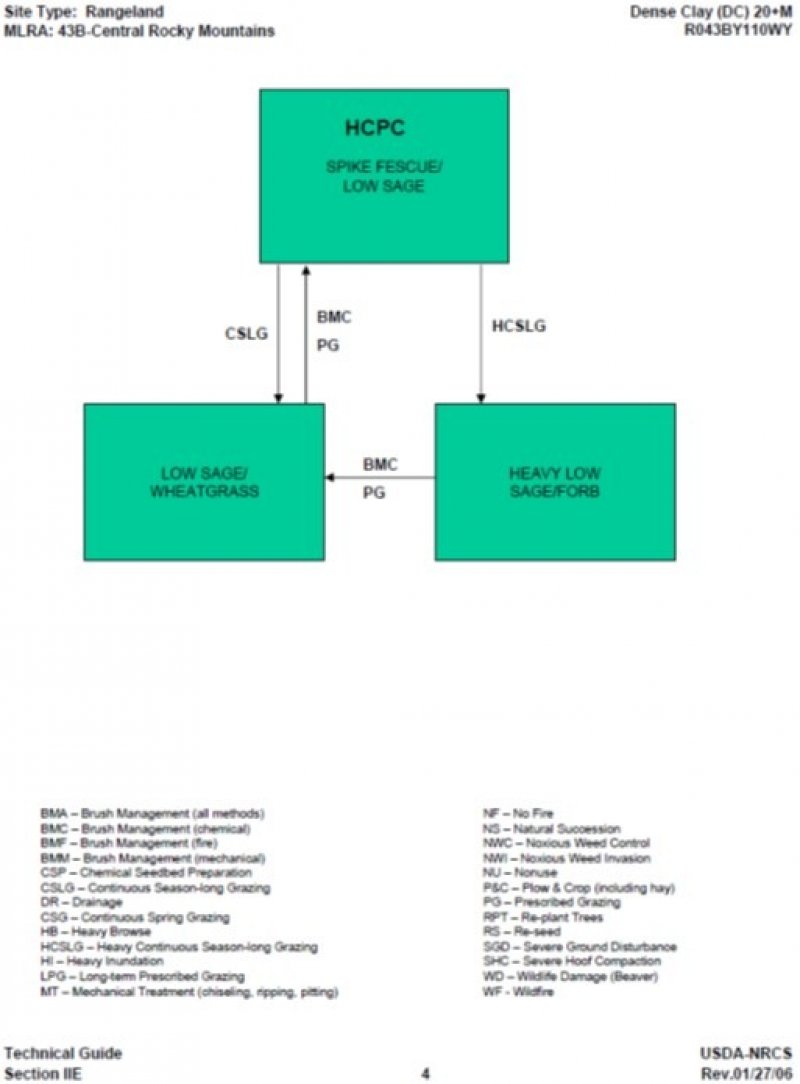
Natural Resources
Conservation Service
Ecological site EX043B23C104
Clayey (Cy) Absaroka Subalpine Zone
Last updated: 10/04/2019
Accessed: 12/18/2025
General information
Provisional. A provisional ecological site description has undergone quality control and quality assurance review. It contains a working state and transition model and enough information to identify the ecological site.
MLRA notes
Major Land Resource Area (MLRA): 043B–Central Rocky Mountains
Major Land Resource Unit (MLRA) 43B: Central Rocky Mountains
43B – Central Rocky Mountains – The Central Rocky Mountains extends from northern Montana to southern extent of Wyoming and from Idaho to central Wyoming. The southern extent of 43B is comprised of a combination of metamorphic, igneous, and sedimentary mountains and foothills. Climatic changes across this extent are broad and create several unique breaks in the landscape.
Further information regarding MLRAs, refer to: United States Department of Agriculture, Natural Resources Conservation Service. 2006. Land Resource Regions and Major Land Resource Areas of the United States, the Caribbean, and the Pacific Basin. U.S. Department of Agriculture Handbook 296.
Available electronically at: http://www.nrcs.usda.gov/wps/portal/nrcs/detail/soils/ref/?cid=nrcs142p2_053624#handbook.
LRU notes
Land Resource Unit (LRU) 43B23C: Absaroka Subalpine Zone
Based on the shifts in geology, precipitation patterns and other climatic factors, as well as elevation and vegetation, the Absaroka Range was divided into LRU 23. Further division of this LRU is necessary due to the gradient moving from the foothills to the summit, as well as aspect shifts (north/east face versus south/west face). Subset C is the high elevation zone noted for dense timber interspersed with open parks and longer persisting snowpack (within timberline). Precipitation can range from 18 to 20 plus inches and is more noted for the duration of snow cover and shorter growing season. To verify or identify Subset C (the referenced subset for this ecological site), refer to the Wyoming LRU matrix key contained within the Ecological Site Key.
This LRU/Subset occurs on the eastern divide of the Absaroka Range. This LRU starts north of Clark, WY and runs to the Thermopolis, WY area. Once the Absaroka Range merges with the Owl Creek and Wind River Ranges, the climatic patterns and elevational changes shifts the plant community and creates a break in the LRU/Subset.
The extent of soils currently correlated to this ecological site does not fit within the digitized boundary. Many of the noted soils are provisional and will be reviewed and corrected in mapping update projects. Other map units are correlated as small inclusions within other MLRA’s/LRU’s based on elevation, landform, and biological references.
Moisture Regime: Typic Ustic
Temperature Regime: Cryic
Dominant Cover: Rangeland – Sagebrush Steppe (major species is Mountain Big Sagebrush)
Representative Value (RV) Effective Precipitation: 20+ inches (508 mm)
RV Frost-Free Days: 31-65 days
Classification relationships
Relationship to Other Established Classification Systems:
National Vegetation Classification System (NVC):
2 Shrub & Herb Vegetation Class
2.B Temperate & Boreal Grassland & Shrubland Subclass
2.B.2 Temperate Grassland & Shrubland Formation
2.B.2.Na Western North American Grassland & Shrubland Division
M048 Central Rocky Mountain Montane-Foothill Grassland & Shrubland Macro-group
G273 Central Rocky Mountain Lower Montane, Foothill & Valley Grassland Group
Ecoregions (EPA):
Level I: 6 North Western Forested Mountains
Level II: 6.2 Western Cordillera
Level III: 6.2.10 Middle Rockies
Level IV: 6.2.17ao – Absaroka Volcanic Subalpine Zone
6.2.17i – Absaroka – Gallatin Volcanic Mountains
Ecological site concept
• Site receives no additional water.
• Slope is <20%
• Soils are:
o Textures range from loamy sand to very fine sandy loam in top 4” (10 cm) of mineral soil surface
o Clay content is ≥35% in top 4” (10 cm) of mineral soil surface
o All subsurface horizons in the particle size control section have a weighted average of ≥ 35% clay. (The particle size control section is the segment of the profile from either the start of an argillic horizon for 50 cm’s or from 25-100 cm’s).
o Moderately deep to very deep (20-80+ in. (50-200+ cm)
o <3% stone and boulder cover and 20% or less cobble and gravel cover
o Not skeletal (<35% rock fragments) within 20” (50 cm) of mineral soil surface
o None to Slightly effervescent throughout top 20” (50 cm) of mineral soil surface
o Non-saline, sodic, or saline-sodic
The Clayey ecological site concept is based on minimal (none to slight) influence from salts, carbonates, gypsum or other chemistry within the top 20 inches (50 cm) of the mineral soil surface. The main soil characteristic is a moderately deep to very deep soil that is fine textured with greater than or equal to 35% clay throughout the soil profile; the dominant soil textural classes are loamy sand to sandy loam in the subsurface.
The clayey site can be found occurring in a complex mosaic pattern where the geology is controlled by inter-bedded sandstone and shale. Locations controlled by primarily shale bedrock have pockets of dense clay and loamy sites intermixed with the clayey ecological site. Dense clay and clayey vary by the abrupt changes for dense clay, and the consistent clay layer for the clayey site.
Associated sites
| R043BY122WY |
Loamy High Mountains |
|---|
Similar sites
| R043BY210WY |
Dense Clay Foothills and Mountains West Dense Clay (DC) 15-19W has lower production. |
|---|---|
| R043BY110WY |
Dense Clay High Mountains Dense Clay (DC) 20+ has lower production, and a shift in the shrub component. |
Table 1. Dominant plant species
| Tree |
Not specified |
|---|---|
| Shrub |
(1) Artemisia tridentata ssp. vaseyana |
| Herbaceous |
(1) Festuca idahoensis |
Legacy ID
R043BX704WY
Click on box and path labels to scroll to the respective text.
